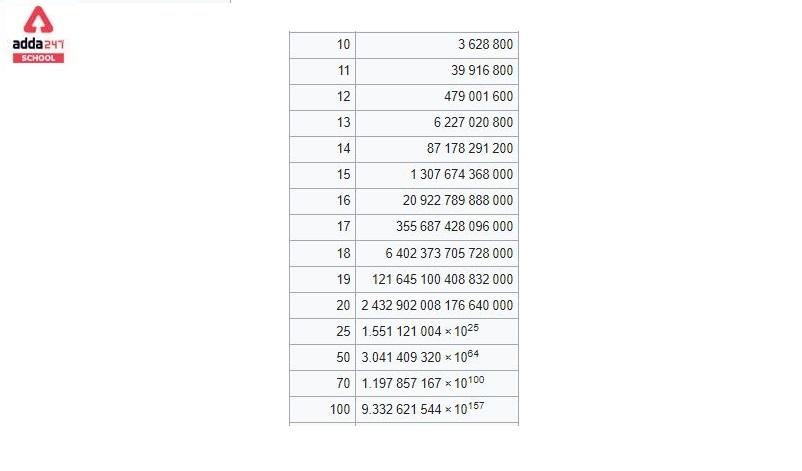Table of Contents
What is the Factorial of 100?
| 9.332622e+157 |
After calculation, the value of Factorial 100 comes out to be equal to 9.332622e+157.
What is the Factorial of 100 Voice Command Answer Android
How to calculate What is the factorial of Hundred(100)?
The answer of what is the factorial of 100
-
- 100! is exactly: 93326215443944152681699238856266700490715968264381621468592963895217599993229915608941463976156518286253697920827223758251185210916864000000000000000000000000
- The approximate value of 100! is 9.3326215443944E+157.
- The number of trailing zeros in 100! is 24.
- The number of digits in 100 factorial is 158.
- The factorial of 100 is calculated, through its definition, this way:
100! = 100 • 99 • 98 • 97 • 96 … 3 • 2 • 1
What is Factorial?
The product of all positive integers less than or equal to a given positive integer, indicated by that integer plus an exclamation point, is known as actorial in mathematics. As a result, factorial seven is expressed as 7!, which means 1 2 3 4 5 6 7. The factororial zero is equal to one. In the evaluation of permutations and combinations, as well as the coefficients of terms in binomial expansions, factororials are frequently encountered Nonintegral values have been included in factororials. Factorials were found by Jewish mystics in the Talmudic book Sefer Yetzirah and by Indian mathematicians in the canonical works of Jain literature. The factorial operation appears in many fields of mathematics, particularly in combinatorics, where its most fundamental use counts the number of unique sequences – permutations – of n distinct objects: there are n! Factorials are employed in power series for the exponential function and other functions in mathematical analysis, and they can also be found in algebra, number theory, probability theory, and computer science.
Much of the factorial function’s mathematics was established in the late 18th and early 19th century. Stirling’s approximation approximates the factorial of huge numbers accurately, demonstrating that it grows faster than exponential growth. Legendre’s formula can be used to count the factorials’ trailing zeros by describing the exponents of prime numbers in a prime factorization of the factorials. The factorial function was interpolated by Daniel Bernoulli and Leonhard Euler to a continuous function of complex numbers, the gamma function, except for the negative integers. The factorials are closely related to many other famous functions and number sequences, including binomial coefficients, double factorials, falling factorials, primorials, and subfactorials. Implementations of the factorial function are used in scientific calculators and scientific computing software libraries and are frequently cited as examples of various computer programming approaches. Although computing big factorials directly using the product formula or recurrence is inefficient, faster algorithms exist that match the time for fast multiplication procedures for numbers with the same number of digits to within a constant factor.
What is Factorial of 100- How to Calculate Factorial?
The factorial function of a positive integer n n is defined by the product:
In product notation, this might be stated more succinctly as
If all but the last term is kept in this product formula, it will define a product of the same form for a smaller factorial. This results in a recurrence relation, according to which each factorial function value may be generated by multiplying the preceding value by n.
Factorial of 100- Applications of Factorial
The factorial function was first used to count permutations: there are n! different ways to arrange n different objects into a series. Factorials are used more widely in combinatorics formulas to account for different object orderings. The binomial coefficients (n k), for example, count the k-element combinations (subsets of k elements) from a collection of n elements and can be obtained using factorials. The factorials are added to the Stirling numbers of the first kind, and the permutations of n are counted in subsets with the same number of cycles. Counting derangements, or permutations that do not leave any element in its original location, is another combinatorial application; the number of derangements of n items equals the nearest integer to n! / e.
The binomial theorem, which employs binomial coefficients to expand powers of sums, gives rise to factorials in mathematics. They can also be found in the coefficients that are used to connect specific families of polynomials, such as Newton’s identities for symmetric polynomials. The factorials are the orders of finite symmetric groups, which explains their application in counting permutations algebraically. Factorials appear in Faà di Bruno’s formula for chaining higher derivatives in calculus. Factorials regularly appear in the denominators of power series in mathematical analysis, most notably in the series for the exponential function.



 SOF Olympiad Exam Date 2024-25 Out, Chec...
SOF Olympiad Exam Date 2024-25 Out, Chec...
 NEET Revised Answer Key 2024 Out, Downlo...
NEET Revised Answer Key 2024 Out, Downlo...
 Karnataka PGCET Admit Card 2024 Out, Dow...
Karnataka PGCET Admit Card 2024 Out, Dow...












